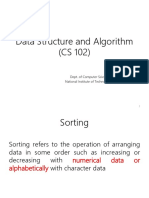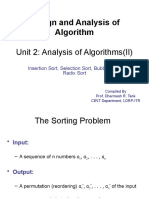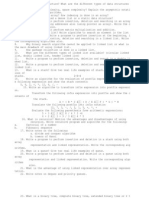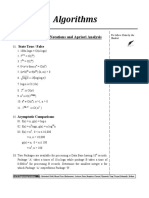Sorting: Definition
Sorting: an operation that segregates
items into groups according to specified
criterion.
A={3162134590}
A={0112334569}
�Review of Complexity
Most of the primary sorting algorithms
run on different space and time
complexity.
Time Complexity is defined to be the time
the computer takes to run a program (or
algorithm in our case).
Space complexity is defined to be the
amount of memory the computer needs
to run a program.
�O(n), (n), & (n)
An algorithm or function T(n) is O(f(n)) whenever
T(n)'s rate of growth is less than or equal to f(n)'s
rate.
An algorithm or function T(n) is (f(n)) whenever
T(n)'s rate of growth is greater than or equal to
f(n)'s rate.
An algorithm or function T(n) is (f(n)) if and
only if the rate of growth of T(n) is equal to f(n).
�Types of Sorting Algorithms
There are many, many different types of
sorting algorithms, but the primary ones
are:
Bubble Sort
Selection Sort
Insertion Sort
Merge Sort
Quick Sort
Shell Sort
Radix Sort
Swap Sort
Heap Sort
�Bubble Sort Example
Quiz Time
1. Which number is definitely in its correct position at the
end of the first pass?
2. How does the number of comparisons required change as
the pass number increases?
3. How does the algorithm know when the list is sorted?
4. What is the maximum number of comparisons required
for a list of 10 numbers?
�Bubble Sort: Example
1
40
43
65
40
43
-1 58
40
-1 43
-1
40
-1 58
42
42
65
42
58 65
42
43 58 65
Notice that at least one element will be
in the correct position each iteration.
�Bubble Sort: Example
5
-1
40
-1
40 42 43 58 65
-1
40 42 43 58 65
-1
40 42 43 58 65
42 43 58 65
�Bubble Sort: Analysis
Running time:
Worst case: O(N2)
Best case: O(N)
Variant:
bi-directional bubble sort
original bubble sort: only works to one
direction
bi-directional bubble sort: works back and
forth.
�Selection Sort: Idea
1. We have two group of items:
sorted group, and
unsorted group
2. Initially, all items are in the unsorted
group. The sorted group is empty.
We assume that items in the unsorted
group unsorted.
We have to keep items in the sorted
group sorted.
�Selection Sort: Contd
1. Select the best (eg. smallest) item
from the unsorted group, then put
the best item at the end of the
sorted group.
2. Repeat the process until the unsorted
group becomes empty.
�Selection Sort
1
Comparison
Data Movement
Sorted
�Selection Sort
1
Comparison
Data Movement
Sorted
�Selection Sort
1
Comparison
Data Movement
Sorted
�Selection Sort
1
Comparison
Data Movement
Sorted
�Selection Sort
1
Comparison
Data Movement
Sorted
�Selection Sort
1
Comparison
Data Movement
Sorted
�Selection Sort
1
Comparison
Data Movement
Sorted
�Selection Sort
Largest
Comparison
Data Movement
Sorted
�Selection Sort
1
Comparison
Data Movement
Sorted
�Selection Sort
1
Comparison
Data Movement
Sorted
�Selection Sort
1
Comparison
Data Movement
Sorted
�Selection Sort
1
Comparison
Data Movement
Sorted
�Selection Sort
1
Comparison
Data Movement
Sorted
�Selection Sort
1
Comparison
Data Movement
Sorted
�Selection Sort
1
Comparison
Data Movement
Sorted
�Selection Sort
Largest
Comparison
Data Movement
Sorted
�Selection Sort
1
Comparison
Data Movement
Sorted
�Selection Sort
1
Comparison
Data Movement
Sorted
�Selection Sort
1
Comparison
Data Movement
Sorted
�Selection Sort
1
Comparison
Data Movement
Sorted
�Selection Sort
1
Comparison
Data Movement
Sorted
�Selection Sort
1
Comparison
Data Movement
Sorted
�Selection Sort
Largest
Comparison
Data Movement
Sorted
�Selection Sort
1
Comparison
Data Movement
Sorted
�Selection Sort
1
Comparison
Data Movement
Sorted
�Selection Sort
1
Comparison
Data Movement
Sorted
�Selection Sort
1
Comparison
Data Movement
Sorted
�Selection Sort
1
Comparison
Data Movement
Sorted
�Selection Sort
Largest
Comparison
Data Movement
Sorted
�Selection Sort
1
Comparison
Data Movement
Sorted
�Selection Sort
1
Comparison
Data Movement
Sorted
�Selection Sort
1
Comparison
Data Movement
Sorted
�Selection Sort
1
Comparison
Data Movement
Sorted
�Selection Sort
Largest
Comparison
Data Movement
Sorted
�Selection Sort
2
Comparison
Data Movement
Sorted
�Selection Sort
DONE!
Comparison
Data Movement
Sorted
�Selection Sort: Example
40
43
65
-1 58
42
40
43
-1 58
42 65
40
43
-1 42
58 65
40
-1 42 43 58 65
�Selection Sort: Example
40
-1 42 43 58 65
-1
40 42 43 58 65
-1
40 42 43 58 65
-1
40 42 43 58 65
�Selection Sort: Example
-1
40 42 43 58 65
-1
40 42 43 58 65
-1
40 42 43 58 65
-1
40 42 43 58 65
-1
40 42 43 58 65
�Selection Sort: Analysis
Running time:
Worst case: O(N2)
Best case: O(N2)
�Insertion Sort: Idea
Idea: sorting
8 | 5 9 2
5 8 | 9 2
5 8 9 | 2
2 5 8 9 |
2 5 6 8 9
2 3 5 6 8
cards.
6 3
6 3
6 3
6 3
| 3
9 |
�Insertion Sort: Idea
1. We have two group of items:
sorted group, and
unsorted group
2. Initially, all items in the unsorted group and the sorted
group is empty.
We assume that items in the unsorted group unsorted.
We have to keep items in the sorted group sorted.
3. Pick any item from, then insert the item at the right
position in the sorted group to maintain sorted
property.
4. Repeat the process until the unsorted group becomes
empty.
�Insertion Sort: Example
40
43
65
-1 58
42
40
43
65
-1 58
42
40 43
65
-1 58
42
�Insertion Sort: Example
1
40 43
65
-1 58
42
40 43 65
-1 58
42
40 43 65
-1 58
42
�Insertion Sort: Example
1
40 43 65
-1
0
1
0
2
1
-1 58
42
40 43 65 -1 58
42
3
2
40
3 40
43 43
65 65 58
42
�Insertion Sort: Example
-1
0
1
0
2
1
3
2
40
3 40
43 43
65 58 65
42
-1
0
1
0
2
1
3
2
40
3 43
3 40
65 43
43
58 58
65 65 42
-1
0
1
0
2
1
3
2
40
3 43
3 40
65 42 43
43
65 58 65
-1
0
1
0
2
1
3
2
40
3 43
3 43
65
4 40
42 42
65 43
43
58 58
65 65
�Insertion Sort: Analysis
Running time analysis:
Worst case: O(N2)
Best case: O(N)
�A Lower Bound
Bubble Sort, Selection Sort, Insertion
Sort all have worst case of O(N2).
Turns out, for any algorithm that
exchanges adjacent items, this is the
best worst case: (N2)
In other words, this is a lower bound!
�Mergesort
Mergesort (divide-and-conquer)
Divide array into two halves.
A
A
L
L
G
G
O
O
R
R
T
I
H
T
M
H
S
M
divide
�Mergesort
Mergesort (divide-and-conquer)
Divide array into two halves.
Recursively sort each half.
A
divide
sort
�Mergesort
Mergesort (divide-and-conquer)
Divide array into two halves.
Recursively sort each half.
Merge two halves to make sorted whole.
A
divide
sort
merge
�Merging
Merge.
Keep track of smallest element in each sorted half.
Insert smallest of two elements into auxiliary array.
Repeat until done.
smallest
G
A
smallest
T
auxiliary array
�Merging
Merge.
Keep track of smallest element in each sorted half.
Insert smallest of two elements into auxiliary array.
Repeat until done.
smallest
G
A
L
G
smallest
T
auxiliary array
�Merging
Merge.
Keep track of smallest element in each sorted half.
Insert smallest of two elements into auxiliary array.
Repeat until done.
smallest
G
A
L
G
O
H
smallest
T
auxiliary array
�Merging
Merge.
Keep track of smallest element in each sorted half.
Insert smallest of two elements into auxiliary array.
Repeat until done.
smallest
G
A
L
G
smallest
O
H
R
I
T
auxiliary array
�Merging
Merge.
Keep track of smallest element in each sorted half.
Insert smallest of two elements into auxiliary array.
Repeat until done.
smallest
G
A
L
G
smallest
O
H
R
I
H
L
T
auxiliary array
�Merging
Merge.
Keep track of smallest element in each sorted half.
Insert smallest of two elements into auxiliary array.
Repeat until done.
smallest
G
A
L
G
O
H
smallest
R
I
H
L
T
auxiliary array
�Merging
Merge.
Keep track of smallest element in each sorted half.
Insert smallest of two elements into auxiliary array.
Repeat until done.
smallest
G
A
L
G
O
H
smallest
R
I
H
L
I
O
T
auxiliary array
�Merging
Merge.
Keep track of smallest element in each sorted half.
Insert smallest of two elements into auxiliary array.
Repeat until done.
smallest
G
A
L
G
O
H
smallest
R
I
H
L
I
O
M
R
T
auxiliary array
�Merging
Merge.
Keep track of smallest element in each sorted half.
Insert smallest of two elements into auxiliary array.
Repeat until done.
first half
exhausted
smallest
G
A
L
G
O
H
R
I
H
L
I
O
M
R
S
S
T
auxiliary array
�Merging
Merge.
Keep track of smallest element in each sorted half.
Insert smallest of two elements into auxiliary array.
Repeat until done.
first half
exhausted
G
A
L
G
O
H
R
I
smallest
H
L
I
O
M
R
S
S
T
T
auxiliary array
�Notes on Quicksort
Quicksort is more widely used than any
other sort.
Quicksort is well-studied, not difficult to
implement, works well on a variety of
data, and consumes fewer resources
that other sorts in nearly all situations.
Quicksort is O(n*log n) time, and O(log
n) additional space due to recursion.
�Quicksort Algorithm
Quicksort is a divide-and-conquer method for
sorting. It works by partitioning an array into
parts, then sorting each part independently.
The crux of the problem is how to partition
the array such that the following conditions
are true:
There is some element, a[i], where a[i] is
in its final position.
For all l < i, a[l] < a[i].
For all i < r, a[i] < a[r].
�Quicksort Algorithm (cont)
As is typical with a recursive program, once you figure
out how to divide your problem into smaller
subproblems, the implementation is amazingly simple.
int partition(Item a[], int l, int r);
void quicksort(Item a[], int l, int r)
{ int i;
if (r <= l) return;
i = partition(a, l, r);
quicksort(a, l, i-1);
quicksort(a, i+1, r);
}
���Partitioning in Quicksort
How do we partition the array efficiently?
choose partition element to be rightmost element
scan from left for larger element
scan from right for smaller element
exchange
repeat until pointers cross
partition element
unpartitioned
left
partitioned
right
�Partitioning in Quicksort
How do we partition the array efficiently?
choose partition element to be rightmost element
scan from left for larger element
scan from right for smaller element
exchange
repeat until pointers cross
swap me
partition element
unpartitioned
left
partitioned
right
�Partitioning in Quicksort
How do we partition the array efficiently?
choose partition element to be rightmost element
scan from left for larger element
scan from right for smaller element
exchange
repeat until pointers cross
swap me
partition element
unpartitioned
left
partitioned
right
�Partitioning in Quicksort
How do we partition the array efficiently?
choose partition element to be rightmost element
scan from left for larger element
scan from right for smaller element
exchange
repeat until pointers cross
swap me
partition element
unpartitioned
left
partitioned
right
�Partitioning in Quicksort
How do we partition the array efficiently?
choose partition element to be rightmost element
scan from left for larger element
scan from right for smaller element
exchange
repeat until pointers cross
swap me
swap me
partition element
unpartitioned
left
partitioned
right
�Partitioning in Quicksort
How do we partition the array efficiently?
choose partition element to be rightmost element
scan from left for larger element
scan from right for smaller element
exchange
repeat until pointers cross
partition element
unpartitioned
left
partitioned
right
�Partitioning in Quicksort
How do we partition the array efficiently?
choose partition element to be rightmost element
scan from left for larger element
scan from right for smaller element
exchange
swap
merepeat until pointers cross
partition element
unpartitioned
left
partitioned
right
�Partitioning in Quicksort
How do we partition the array efficiently?
choose partition element to be rightmost element
scan from left for larger element
scan from right for smaller element
exchange
swap
merepeat until pointers cross
partition element
unpartitioned
left
partitioned
right
�Partitioning in Quicksort
How do we partition the array efficiently?
choose partition element to be rightmost element
scan from left for larger element
scan from right for smaller element
exchange
swap
merepeat until pointers cross
swap me
partition element
unpartitioned
left
partitioned
right
�Partitioning in Quicksort
How do we partition the array efficiently?
choose partition element to be rightmost element
scan from left for larger element
scan from right for smaller element
exchange
repeat until pointers cross
partition element
unpartitioned
left
partitioned
right
�Partitioning in Quicksort
How do we partition the array efficiently?
choose partition element to be rightmost element
scan from left for larger element
scan from right for smaller element
exchange
repeat until pointers cross
partition element
unpartitioned
left
partitioned
right
�Partitioning in Quicksort
How do we partition the array efficiently?
choose partition element to be rightmost element
scan from left for larger element
scan from right for smaller element
exchange
repeat until pointers cross
partition element
unpartitioned
left
partitioned
right
�Partitioning in Quicksort
How do we partition the array efficiently?
choose partition element to be rightmost element
scan from left for larger element
scan from right for smaller element
Exchange and repeat until pointers cross
partition element
unpartitioned
left
partitioned
right
�Partitioning in Quicksort
How do we partition the array efficiently?
choose partition element to be rightmost element
scan from left for larger element
scan from right for smaller element
Exchange and repeat until pointers cross
swap me
partition element
unpartitioned
left
partitioned
right
�Partitioning in Quicksort
How do we partition the array efficiently?
choose partition element to be rightmost element
scan from left for larger element
scan from right for smaller element
Exchange and repeat until pointers cross
swap me
partition element
unpartitioned
left
partitioned
right
�Partitioning in Quicksort
How do we partition the array efficiently?
choose partition element to be rightmost element
scan from left for larger element
scan from right for smaller element
Exchange and repeat until pointers cross
swap me
partition element
unpartitioned
left
partitioned
right
�Partitioning in Quicksort
How do we partition the array efficiently?
choose partition element to be rightmost element
scan from left for larger element
scan from right for smaller element
Exchange and repeat until pointers cross
swap me
partition element
unpartitioned
left
partitioned
right
�Partitioning in Quicksort
How do we partition the array efficiently?
choose partition element to be rightmost element
scan from left for larger element
scan from right for smaller element
Exchange and repeat until pointers crossswap with
pointers cross
partition element
partitioning
element
unpartitioned
left
partitioned
right
�Partitioning in Quicksort
How do we partition the array efficiently?
choose partition element to be rightmost element
scan from left for larger element
scan from right for smaller element
Exchange and repeat until pointers cross
partition is
complete
partition element
unpartitioned
left
partitioned
right
�Quicksort Demo
Quicksort illustrates the operation of the basic
algorithm. When the array is partitioned, one
element is in place on the diagonal, the left
subarray has its upper corner at that element,
and the right subarray has its lower corner at
that element. The original file is divided into
two smaller parts that are sorted
independently. The left subarray is always
sorted first, so the sorted result emerges as a
line of black dots moving right and up the
diagonal.
�Why study Heapsort?
It is a well-known, traditional sorting
algorithm you will be expected to
know
Heapsort is always O(n log n)
Quicksort is usually O(n log n) but in the
worst case slows to O(n2)
Quicksort is generally faster, but
Heapsort is better in time-critical
applications
�What is a heap?
Definitions of heap:
1. A large area of memory from which the
programmer can allocate blocks as
needed, and deallocate them (or allow
them to be garbage collected) when no
longer needed
2. A balanced, left-justified binary tree in
which no node has a value greater
than the value in its parent
Heapsort uses the second definition
�Balanced binary trees
Recall:
The depth of a node is its distance from the root
The depth of a tree is the depth of the deepest node
A binary tree of depth n is balanced if all the nodes at depths 0 through
n-2 have two children
n-2
n-1
n
Balanced
Balanced
Not balanced
�Left-justified binary trees
A balanced binary tree is left-justified if:
all the leaves are at the same depth, or
all the leaves at depth n+1 are to the left of
all the nodes at depth n
Left-justified
Not left-justified
�The heap property
A node has the heap property if the
value in the node is as large as or
larger than the values in its children
12
8
12
3
Blue node has
heap property
12
12
Blue node has
heap property
14
Blue node does not
have heap property
All leaf nodes automatically have the heap property
A binary tree is a heap if all nodes in it have the
heap property
�siftUp
Given a node that does not have the heap
property, you can give it the heap property by
exchanging its value with the value of the
larger child
14
12
8
8
14
12
Blue node has
heap property
Blue node does not
have heap property
This is sometimes called sifting up
Notice that the child may have lost the heap
property
�Constructing a heap I
A
tree consisting of a single node is automatically a heap
We construct a heap by adding nodes one at a time:
Add the node just to the right of the rightmost node in the
deepest level
If the deepest level is full, start a new level
Examples:
Add a new
node here
Add a new
node here
�Constructing a heap II
Each time we add a node, we may destroy the heap property of its
parent node
To fix this, we sift up
But each time we sift up, the value of the topmost node in the sift may
increase, and this may destroy the heap property of its parent node
We repeat the sifting up process, moving up in the tree, until either
We reach nodes whose values dont need to be swapped (because
the parent is still larger than both children), or
We reach the root
�Constructing a heap III
8
10
10
12
10
8
10
10
5
12
8
12
5
10
8
�Other children are not affected
12
10
8
12
5
14
14
8
14
5
10
12
8
5
10
The node containing 8 is not affected because its parent gets
larger, not smaller
The node containing 5 is not affected because its parent gets
larger, not smaller
The node containing 8 is still not affected because, although its
parent got smaller, its parent is still greater than it was originally
�A sample
heap
Heres a sample binary tree after it has been
heapified
25
22
19
18
17
22
14
21
14
3
15
11
Notice that heapified does not mean sorted
Heapifying does not change the shape of the
binary tree; this binary tree is balanced and
left-justified because it started out that way
�Removing
the
root
Notice that the largest number is now in the root
Suppose we discard the root:
11
22
19
18
17
22
14
21
14
3
15
11
How can we fix the binary tree so it is once
again balanced and left-justified?
Solution: remove the rightmost leaf at the
deepest level and use it for the new root
�The
reHeap method I
Our tree is balanced and left-justified, but no longer a heap
However, only the root lacks the heap property
11
22
19
18
17
22
14
21
14
3
15
We can siftUp() the root
After doing this, one and only one of its
children may have lost the heap property
�The reHeap method II
Now the left child of the root (still the
number 11) lacks the heap property
22
11
19
18
17
22
14
21
14
3
15
We can siftUp() this node
After doing this, one and only one of its
children may have lost the heap property
�The
reHeap method III
Now the right child of the left child of the root
(still the number 11) lacks the heap property:
22
22
19
18
17
11
14
21
14
3
15
We can siftUp() this node
After doing this, one and only one of its children may
have lost the heap property but it doesnt, because
its a leaf
�The reHeap method IV
Our tree is once again a heap, because
every node in it has the heap property
22
22
19
18
17
21
14
11
14
3
15
Once again, the largest (or a largest) value is in the root
We can repeat this process until the tree becomes empty
This produces a sequence of values in order largest to
smallest
�Sorting
What do heaps have to do with sorting an array?
Heres the neat part:
Because the binary tree is balanced and left justified,
it can be represented as an array
All our operations on binary trees can be represented
as operations on arrays
To sort:
heapify the array;
while the array isnt empty {
remove and replace the root;
reheap the new root node;
}
�Mapping into an25array
22
17
19
18
0
22
14
14
21
3
3
5
9
7
15
11
10
25 22 17 19 22 14 15 18 14 21 3
11
12
9 11
Notice:
The left child of index i is at index 2*i+1
The right child of index i is at index 2*i+2
Example: the children of node 3 (19) are 7 (18) and 8
(14)
�Removing and replacing the
root
The root is the first element in the array
The rightmost node at the deepest level is the last
element
Swap them...
0
10
25 22 17 19 22 14 15 18 14 21 3
10
11 22 17 19 22 14 15 18 14 21 3
11
12
9 11
11
12
9 25
...And pretend that the last element in the array
no longer existsthat is, the last index is 11 (9)
�Reheap and repeat
Reheap the root node (index 0, containing
0 )...
1 2
3 4
5 6
7
8 9 10 11 12
11
11 22 17 19 22 14 15 18 14 21 3
0
10
22 22 17 19 21 14 15 18 14 11 3
10
9 25
11
12
9 25
11
12
9 22 17 19 22 14 15 18 14 21 3 22 25
...And again, remove and replace the root node
Remember, though, that the last array index is changed
Repeat until the last becomes first, and the array is sorted!
�Analysis I
Heres how the algorithm starts:
heapify the array;
Heapifying the array: we add each of
n nodes
Each node has to be sifted up, possibly
as far as the root
Since the binary tree is perfectly balanced,
sifting up a single node takes O(log n) time
Since we do this n times, heapifying
takes n*O(log n) time, that is, O(n log n)
time
�Analysis II
Heres the rest of the algorithm:
while the array isnt empty {
remove and replace the root;
reheap the new root node;
}
We do the while loop n times (actually, n-1
times), because we remove one of the n
nodes each time
Removing and replacing the root takes O(1)
time
Therefore, the total time is n times however
long it takes the reheap method
�Analysis III
To reheap the root node, we have to follow
one path from the root to a leaf node (and we
might stop before we reach a leaf)
The binary tree is perfectly balanced
Therefore, this path is O(log n) long
And we only do O(1) operations at each node
Therefore, reheaping takes O(log n) times
Since we reheap inside a while loop that we
do n times, the total time for the while loop is
n*O(log n), or O(n log n)
�Analysis IV
Heres the algorithm again:
heapify the array;
while the array isnt empty {
remove and replace the root;
reheap the new root node;
}
We have seen that heapifying takes O(n log
n) time
The while loop takes O(n log n) time
The total time is therefore O(n log n) + O(n log
n)
This is the same as O(n log n) time
�The End
�Shell Sort: Idea
Donald Shell (1959): Exchange items that are far apart!
Original:
40
43
65
-1 58
42
42
5-sort: Sort items with distance 5 element:
40
43
65
-1 58
�Original:
Shell
40
Sort: Example
2
43
65
-1 58
42
-1 43
42
58
65
-1
40
42 43 65 58
2
1
3
2
40
3 43
3 43
65
4 40
42 42
65 43
43
58 58
65 65
After 5-sort:
40
After 3-sort:
2
After 1-sort:
-1
0
1
0
�Shell Sort: Gap Values
Gap: the distance between items being
sorted.
As we progress, the gap decreases.
Shell Sort is also called Diminishing Gap
Sort.
Shell proposed starting gap of N/2,
halving at each step.
There are many ways of choosing the
next gap.
�Shell Sort: Analysis
O(N3/2)?
O(N5/4)?
O(N7/6)?
So we have 3 nested loops, but Shell Sort is still better
than Insertion Sort! Why?
�Generic Sort
So far we have methods to sort integers. What about
Strings? Employees? Cookies?
A new method for each class? No!
In order to be sorted, objects should be comparable
(less than, equal, greater than).
Solution:
use an interface that has a method to compare two
objects.
Remember: A class that implements an interface
inherits the interface (method definitions) = interface
inheritance, not implementation inheritance.
�Other kinds of sort
Heap sort. We will discuss this after
tree.
Postman sort / Radix Sort.
etc.






















































































